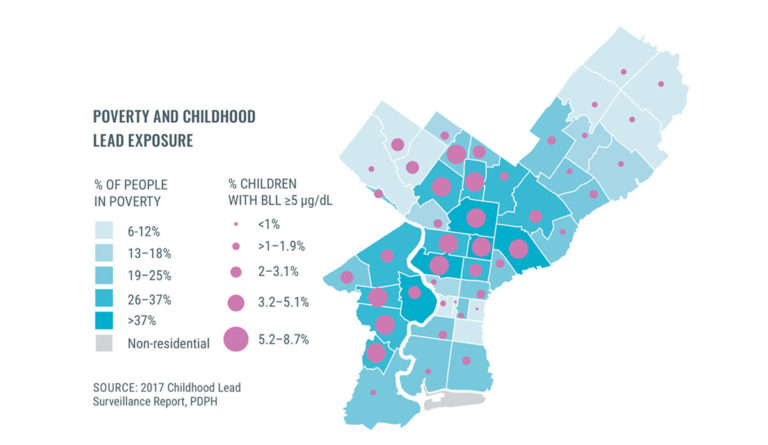Poverty and Pb in Philadelphia
Philadelphia’s communities with higher poverty rates correspond with higher levels of lead exposure, which can have detrimental health effects for children.

Read Time: 2 minutes
Published:
Childhood lead exposure is often highest among neighborhoods with high poverty rates. In the map above, Philadelphia’s zip codes with higher poverty rates are seen in darker shades of blue and generally correspond with higher levels of lead exposure, which are represented by larger pink circles.
While blood lead levels among children in Philadelphia have decreased over the years—from a high of 10.3% in 2008 to 3.4% in 2017—the potential for exposure remains high. Lead-based paint and lead-contaminated dust found in older buildings are the main sources of exposure among children in the United States.
Approximately 50% of Philadelphia houses were built prior to 1950. Use of lead-based paints for housing was not banned until 1978 and so with many of the older homes, gradual deterioration of the exteriors puts children at risk. Almost 24 million housing units in the country are dropping paint chips and throwing off lead-contaminated dust and the cost of stripping and repainting is overwhelming.
There are no safe levels of lead exposure, but the Centers for Disease Control and Prevention recommends treatment for children with blood lead levels greater than 5 micrograms of lead per deciliter of blood. Left untreated, high blood lead levels can result in developmental delays and hearing and speech impairments, as well as damage to the brain and other vital organs.
To prevent toxic levels of lead of exposure, the Philadelphia Lead and Healthy Homes Program was established to improve the health and safety of housing in the city. The program works with families, homeowners, and landlords to reduce lead hazards in affected homes. If a child tests positive for high levels of lead exposure, a licensed lead inspector is sent to the child’s home to inspect every painted surface and determine the hazardous sources.
Databyte via Philadelphia Childhood Lead Poisoning Surveillance Report. Department of Public Health, City of Philadelphia, 2017.



